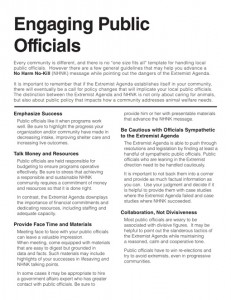In Memory of Oreo. Killed: November 13, 2009.

Two years ago in New York City, a then-one-year old dog named Oreo was intentionally thrown off a sixth floor Brooklyn roof top by her abuser. Oreo sustained two broken legs and a fractured rib. Oreo also appears to have been beaten in the past—several of the neighbors in the building where Oreo lived reported hearing the sounds of the dog being hit. The ASPCA nursed her back to health and arrested the perpetrator. They also dubbed her the “miracle dog.”
The miracle was short-lived. According to the ASPCA, when Oreo recovered from her injuries, she started to show aggression. After a series of temperament tests (which were videotaped but they refuse to make public), the ASPCA made the decision to kill her. The New York Times reported the story the day before Oreo’s scheduled execution. A sanctuary in New York offered to take Oreo, explaining that they had experience rehabilitating dogs deemed aggressive and offering her lifetime care, including plenty of socialization and walks if the rehabilitation was not successful.
They were ignored, hung up on and lied to. And the ASPCA—reputed to have raised millions of dollars off of Oreo—chose to kill the dog instead. Two years ago today, Oreo laid dead, the victim not of her former abuser, but of an overdose of poison from a bottle marked “Fatal-Plus,” at the hands of a shelter bureaucrat, and at the behest of ASPCA President Ed Sayres.
Following the furor that erupted over Oreo’s killing, New York State legislators introduced a bill to prevent animals from being killed by shelters when there is a lifesaving alternative offered by rescue groups. “As a dog owner and a foster parent for an animal rescue group, I was heartbroken to learn that Oreo was [killed]. When a humane organization volunteers their expertise in difficult cases, a shelter should work with them to the fullest extent possible,” said one of the legislative sponsors. “I am hopeful that Oreo’s Law will ensure that no animal is ever put to death if there is a responsible alternative.” (A few weeks later, and despite the furor that had erupted over Oreo’s killing, Ed Sayres did it again, killing a dog named Max whom a rescue group had offered to save.)
For far too long, those running our animal shelters—agencies funded by the philanthropic donations and tax dollars of an animal loving American public—have refused to mirror our progressive values. For far too long, they have assumed a power and authority to act independent of public opinion, and the will of the people who have entrusted them to do their jobs with compassion, dedication and integrity. In betraying this trust time and time again, they have proven that they can’t be trusted, and that we must regulate them in the same way we regulate other agencies which hold the power of life and death: by removing the discretion which has for too long allowed them to thwart the public’s will and to kill animals who should be saved.
Sadly, we cannot bring Oreo back and give her the second chance the ASPCA denied her. And we will forever remember her killing at the hands of those who were supposed to protect her from further harm as many things: tragic and heartbreaking, chief among them. Nothing can alter that calculus. But we can lessen the futility of Oreo’s death if we learn from it, and alter our society in such a way as to prevent such a betrayal from ever happening again.
While Oreo is the most famous of all the animals killed in New York State despite a rescue alternative, sadly, neither she, nor Max, are alone nor unique. New York State shelters routinely turn away rescue groups and then turn around and kill the kittens and cats, puppies, dog, rabbits and other animals those rescue groups offered to save. A statewide survey of rescue groups found that 72% of rescue groups reported being denied animals, and 71% reported shelters turned around and killed those very animals instead.
Today, we are trying to bring sanity to New York State’s shelter policy by passing legislation to make this illegal. But the ASPCA is committed to not letting that happen. To defend its position, Ed Sayres accused rescue groups of being hoarders and dog fighters in disguise. And to legitimize that position, he recruited Francis Battista of Best Friends, Jane Hoffman of the Mayor’s Alliance, and killing pounds across New York State to parrot those claims. And they succeeded. Like its namesake, Oreo’s Law was killed by the ASPCA. And the body count has been unthinkable.
Since the ASPCA succeeded in defeating Oreo’s Law, 35,607 animals who rescue groups were willing to save have been killed instead. It is not easy to conceptualize 35,000 dead animals. But if you were driving along the road and each of those bodies was lined up end to end along the side, that monumental trail of dead bodies would stretch approximately 10 miles long. Put another way, they would fill virtually all of the seats at Fenway Park in Boston.

And put still another way, each death is represented by one paw below:

And while Hoffman and Sayres dug in their heels and continue to fight rescue rights of access, Battista and Best Friends, despite their best efforts to paint rescuers as hoarders, eventually caved in to popular discontent. The following year, they supported the legislation. But the damage was done. Not just in terms of animals killed who could never be brought back, but because it emboldened the ASPCA in a way that isolation might have prevented (as we will see below). In fact, the ASPCA opposition to rescue group rights has spilled over to other states. In Texas, Hope’s Law, which would have mandated rescue rights, was defeated by a coalition that includes ASPCA partner organizations, including one of its shelters of the year; a “shelter” which kills most animals, including all dogs who look like “pit bulls.” In Minnesota, one of the state’s most regressive kill shelters is opposing the legislation there, citing the ASPCA’s opposition to legitimize its desire to continue killing even in the face of a rescue alternative. In Florida, the rescue rights law introduced has already encountered opposition, despite the fact that 63% of rescue groups in that state reported being turned away by a shelter and that shelter then killed the animals they were willing to save. In Connecticut, ASPCA-sponsored legislation made it nearly impossible for rescue groups to import animals threatened with being killed in other states to safe homes in Connecticut.

And just this week in Michigan, a scared, skinny dog wandered into an Ace hardware store in Detroit in search of food, warmth, and a loving hand. Named “Ace,” rescue groups offered to save him, but Detroit Animal Control put him to death anyway. Their reasoning? If we allow a rescue group to save one pit bull, they’ll want to save others. And that is something Detroit’s hard-hearted, small-minded Department of Environmental Health Services will not allow to happen. The store owner issued this memorial:
Dear Ace, you came into my lobby, crouched behind my door and stared blankly at the wall, shaking. I could see your pain – I fed you, warmed you and you rewarded me by finally looking into my eyes, and for a moment, we shared your pain. I reached for the phone, thinking that I could find you a better life… Instead I sent you to your death. Please forgive me. You did not die in vain, nor will you be forgotten. This I promise you. Your last but far from only friend. – Mark
I’ve been in touch with the group that was fighting to save Ace about introducing a rescue access law in Michigan that would prevent this kind of tragedy from happening again. Will the ASPCA fight us there too? Invariably. Is this the kind of killing they embrace? Absolutely.
While ASPCA intransigence is nothing knew (it has been asleep at the wheel since the great Henry Bergh’s death in 1888), its war on rescue groups, reform advocates, and grassroots activists is a signature policy under the disastrous tenure of the Sayres administration. He fought reform efforts in San Francisco, insisting on the right of shelters to kill animals, despite readily available lifesaving alternatives. He backed a pound director in Austin, Texas, even after she committed animal cruelty by withholding medical care from sick and injured animals, allowing them to suffer. And he continues to allow sick and injured animals to go without needed pain management and medical care in New York City’s pound, while claiming it is a model of compassionate care, even while rescuers and volunteers who speak out are turned away from helping those animals. And it gets worse.
Ed Sayres’ war on animal lovers reached its pinnacle this week with the online publication of a “handbook” for killing shelters on how to fight reform efforts and stave off calls for an end to the killing. The ASPCA admits that “there does exist public attention to the need to reform the sheltering system to increase lifesaving,” but they want to help kill shelters bury it. One of the documents, in particular, caused a firestorm: “Tactics of the Extremist Agenda.” According to the Sayres administration, rescuers and animal lovers who want to end the killing and who engage in the democratic process to do so, are “extremists” and the legislators who agree with them should be handled with “caution.”

The documents are the work of none other than Sayres’ henchman in Austin, Karen Medicus, who was responsible for an 11% increase in killing when she convinced the City to follow her policies; and who has since rewritten history to try to take credit for Austin’s lifesaving success, despite her opposition to it every step of the way. It was Medicus who argued that Austin’s animals were not “desirable” or “placeable” and should be put to death. And it was Medicus who backed the then-pound director, even after she committed animal cruelty by withholding treatment from sick animals.
Medicus’ attack on shelter reformers as “extremists” caused a firestorm on the social media. According to Michael Mountain,
A document entitled The Tactics of the Extremist Agenda, along with advice on how to deal with public officials who may be sympathetic to these extremists, was made public yesterday – and promptly disappeared from sight.
The document began by smearing various grassroots groups as members of the “Extremist Agenda”, and accused them of setting up “proxies” in their communities to act on their behalf, “slandering” local organizations and their directors whom they deemed to be “sympathetic to the status quo,” and “installing a puppet regime.”
He went on to say that “This paranoid view of the grassroots wasn’t coming from the government of Hosni Mubarak or Bashar al Assad in response to the Arab Spring. It was coming from the ASPCA – our nation’s richest and most powerful SPCA.”
Even Sayres-apologist Francis Battista, who once stated that Best Friends would never support legislation opposed by the ASPCA and assisted Sayres in defeating Oreo’s Law, spoke out forcefully against it:
Instead of cooking up fevered fantasies about an Al-Qaeda-like no-kill operation that is on the loose and may be coming to a community near you, one would hope that the ASPCA would be rattling the cages of local SPCAs and shelters and using their considerable influence in those circles to get such organizations to address the actual cause of public unrest, which is not an extremist agenda, but the killing of healthy, treatable pets.
This, of course, begs the question: Why doesn’t Best Friends, with its $40 million in annual revenues, do this? But that aside, in the world of the ASPCA, saving lives is “extremist” but subjecting the animals to daily neglect, cruelty, and the ultimate form of violence—killing—is to be defended and protected. But while both condemnations were forceful, they fell short by pandering to pretensions that this is somehow an aberration among groups otherwise filled with animal lovers. Mountain less so, but he still went on to say that “Large, well-heeled organizations like the ASPCA are staffed by good people who want to help animals. But the leadership has a tendency to become arrogant and paranoid and to see the grassroots as their enemy.” This is wrong. First of all, as to the leadership, it is much more than arrogant and paranoid as addressed below. And secondly, the kind of concerted effort to fight No Kill across the country that the ASPCA takes requires people. It isn’t Ed Sayres sitting alone at his keyboard. He and other leaders of the ASPCA may be calling the shots, but the people of the ASPCA are implementing his regressive policies. Ed Sayes may have ordered Oreo killed, but the people of the ASPCA killed her. Ed Sayres may have ordered Oreo’s Law to be defeated, but the people of the ASPCA walked the halls of the state capitol in Albany and lobbied legislators to vote “No.” Ed Sayres may have ordered the ASPCA to oppose No Kill in San Francisco, but the people of the ASPCA testified against it in front of the San Francisco Animal Welfare Commission. Ed Sayres may have ordered sick kittens sent to New York City’s medieval and abusive pound, but it is ASPCA employees who delivered them there to be killed. Why do we feel the need to apologize for holding them accountable? We can forgive Mountain that error, because everything else he wrote is so spot on. We are, as he says, “fed up with old-guard, do-nothing, establishment organizations that spend much of their time and their donors’ money killing more animals.” But Battista’s conclusion was made up out of whole cloth: “From one organization to another:I know the ASPCA, and I know you can do better than this.”
Really? Where is the proof of that?
This latest assault on those trying to save the lives of animals isn’t an aberration. This is who and what the ASPCA is and has been for a very, very long time. Despite the millions hoarded in their bank accounts raised through emotional commercials that prey on animal lovers by promoting the fiction that they will use donations to save animals, the ASPCA has a long sordid history of not only fighting reform efforts nationwide, but of neglecting the needs of the animals suffering in the shelter down the street, even sending animals to be killed there. In short, why do we feel we have to couch our condemnation in a complement when the ASPCA is committed to killing, to protecting killers, to defending abusers if they happen to run shelters, and to hiding abuse within its own facility as the ASPCA did in trying to protect a veterinarian who kicked a dog to death? Regardless of whether it was run by Roger Caras who called No Kill a “hoax” and a “cancer,” or Larry Hawk, who continued that legacy, or Ed Sayres, who counts over 35,000 dead New York animals as his legacy, there is simply no evidence that the ASPCA “can do better than this” because, when it comes to ending the systematic killing of animals in U.S. shelters, they never have. In fact, they have never even tried, not since the death of their remarkable founder over 120 years ago.
Battista goes on to write, “ASPCA, the train has left the station, and we are en route to a no-kill country. We would love for you to be at the victory party.” And again, Battista misses the mark. The train has left the station and we are en route to a No Kill nation. But the ASPCA won’t be invited to the victory party because when we finally win, it will be because we are celebrating having defeated them. In fact, if it wasn’t for organizations like the ASPCA fighting us, our work would be much less complicated and our conquest of the status quo would be much easier to achieve. We already have the hearts and minds of the American public. It is the entrenched status quo—spearheaded by groups like the ASPCA—that our movement must overcome. We exist to fight them. They are not part of our movement and never have been. They are our antithesis, our nemesis, and the very reason the grassroots No Kill movement must exist in the first place.
I often end my “Building a No Kill Community” seminars with a simple admonition: No more excuses. No more compromises. No more killing. I’d like to add one more: No more apologia. As we remember Oreo’s death on this, the most solemn of anniversaries; as we feel fresh wounds at the killing of Ace, who like Oreo, made the “mistake” of having entered a shelter with a commitment to killing despite a rescue alternative; as we consider the 35,000 additional dead in New York; as we consider the hundreds of thousands similarly killed across the nation because kill shelters refuse to work with rescue groups; and as we fight for the lives of the millions killed every year because of a paradigm, created in part, and defended vigorously by the ASPCA, let us remember that our fight is not against the many, but the few: the heads of regressive shelters like Detroit Animal Services and the heads of the large, national organizations who protect and defend them, organizations like the ASPCA. Let’s not fall into the trap of pretending otherwise because you cannot solve a problem if you do not recognize its cause.
For further information, read Valerie Hayes’ excellent essay on “The ASPCA and the case of the extremely elusive documents,” by clicking here.
♦
Are you an “extremist”? Take the quiz.
- I want the killing to end.
- I think it is wrong for shelters to neglect and abuse animals.
- If other communities can end the killing of savable animals, I believe my community should also.
- I care about animals and because I care about animals, I do not want harm to come to them.
- I believe in democracy and engaging my elected officials to create social change.
If you answered “Yes” to any of these questions, you are an “extremist” according to the ASPCA. If you answered “No” to all of these questions, the ASPCA thinks you’ll make a great shelter director and they will fight to defend and protect you.
